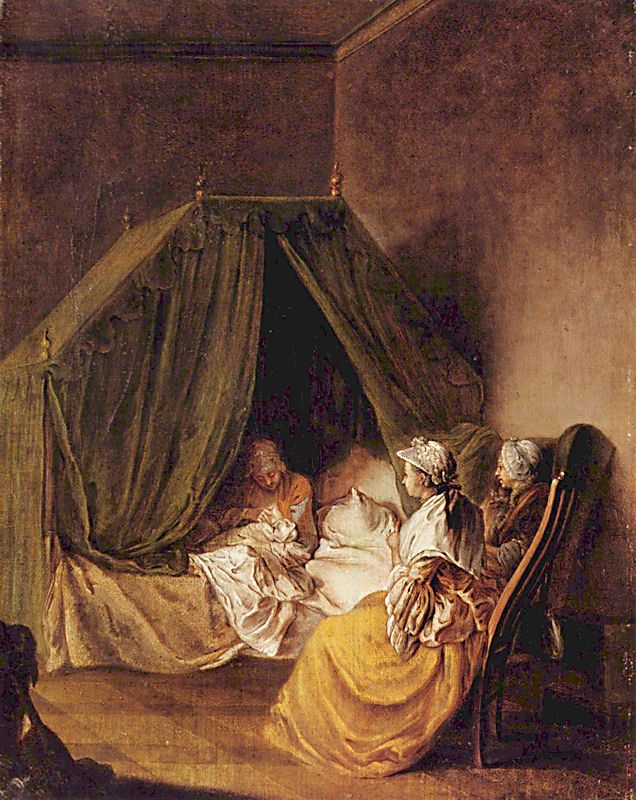Daniel Chodowiecki
Daniel Nikolaus Chodowiecke (Polish pronunciation / xɔdɔvjɛtski / $ * October 16, 1726 in Gdansk, † February 7, 1801 in Berlin) was the most popular German engraver, artist and illustrator of the 18th century. He had Polish and Huguenot ancestors.
Life
Chodowiecke paternal comes from an originally noble family, who lived until 1550 in Great Poland, while his mother was from a Swiss Huguenot descent. He was the son of the Danzig grain wholesaler Chodowiecke Gottfried and his wife Marie Henriette Ayrer. His grandfather, Christian, born in 1655, was also a merchant in Danzig. The miniature painter Gottfried Chodowiecke was his brother. After the death of his father in 1740 Chodowiecke began a commercial apprenticeship.
In 1743 he came to Berlin in the Quincaillerie business ( dt, household goods ') of his uncle Antoine Ayrer. Chodowiecke drew and designed there fashion jewelry. Ayrer then made for artistic training and let his nephew Daniel and Gottfried Johann Jakob Haid of Augsburg teach in the enamel painting. As of 1754, the brothers Chodowiecke made themselves independently as a miniature and enamel painter. During this time Chodowiecke was also student of artist Bernhard Rode and Johann Heinrich Meil.
Just a year later married Chodowiecke in Berlin Johanna Marie (1728-1785), the daughter of the Huguenot Jean Seidensticker Barez from Amsterdam. This marriage tied Chodowiecke in the French community in Berlin, in which he is very dedicated. The couple had six daughters and three sons. Louis Guilleaume (1765-1805) was a painter and engraver, Henri Isaac († 1831) in 1805 at the age of 37 years pastor of the French Reformed Church in Potsdam.
In the almanacs and calendars of the time Chodowiecke could achieve as an illustrator first successes. Later he made his engravings famous all over the world. Chodowiecke illustrated not only works of Gotthold Ephraim Lessing, Johann Wolfgang von Goethe, Friedrich Schiller and the front pages for kids friend of Christian Felix Weisse. Even scholarly works, such as are illustrated with his engravings of Johann Bernhard Basedow, Johann Timotheus Hermes and Christian God Help Salzmann. Also in the translations of the bestseller by Oliver Goldsmith, Miguel de Cervantes Saavedra and Tobias Smollett found his illustrations use.
This enormous work (almost 2300 Etchings) could only cope with a workshop where he could delegate much Chodowiecke. For him, some of the best engraver, engraver and miniaturist of the country worked. The architectural sculpture at the French Dome in Berlin goes back to designs Chodowiecki. With his few paintings the artist had only moderate success.
From 1764 Chodowiecke was a member of the Royal Prussian Academy of Arts, which had fallen during the reign of the economical " soldier king " Friedrich Wilhelm I and his oriented almost exclusively to French culture son and successor Frederick II in stagnation. Chodowiecke strove vigorously to change. In 1783 he supported the appointment of his friend Bernhard Rode to the Director of the Academy. This year, he formulated his ideas about the nature of the Academy: " Academie is a word that means a gathering of artists who, at a place assigned to them, come together at certain times, to confer amicably with each other about their art their experiments, insights and experiences inform one to learn from the other, looking to approach with each of perfection. " Chodowiecke 1783 became secretary of the Academy, and was thus responsible for the academic exhibitions. From 1786 to 1789 he was rector, 1789-1797 Assistant Director. At the academy reform of 1790, he was heavily involved. From 1797 to 1801 - after Rodes death until his own death - he directed the Academy as Director.
In Berlin, he lived from 1755 in Brüderstraße and later 31 in Behrenstraße At the age of 74 years Daniel Nikolaus Chodowiecke died on 7 February 1801 in Berlin. His final resting place he found in the cemetery of the French Reformed church in Berlin. In Berlin -Prenzlauer Berg the Chodowieckistraße is named after him.
Johann Wolfgang von Goethe appreciated the artists very much and described it in his Maxims and Reflections as " a very respectable and we say ideal artist, widely known for his drawings and small engravings, scenes of bourgeois life depicting where it expression and character of the figures often admirably succeeded. More Ideal was in the circles in which he worked not to demand ". In poetry and truth there is to say on the occasion of Nicolai 's rebuttal The Joys of Young Werther: "Those brochure us soon came into the hands. The most delicate vignette of Chodowiecke made me much pleasure as I adored because this artist beyond measure. "
The East German Gallery builds on a research Daniel Chodowiecke.
Works (selection)
Johann Wilhelm Bernhard von Hymmen (1725-1787)
Hans Joachim von Zieten, about 1775
Ex Libris of the artist, copperplate engraving, 1760
Chodowiecke and his family
Brandenburg Gate
The Barez, Chodowiecki laws
Monument
The Berlin sculptor Martin Müller created a marble statue Chodowiecki, which was erected in 1930 in the lobby of the Altes Museum in Berlin.










